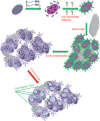Phototherapy-based combination strategies for bacterial infection treatment
- PMID: 33204340
- PMCID: PMC7667673
- DOI: 10.7150/thno.52729
Phototherapy-based combination strategies for bacterial infection treatment
Abstract
The development of nanomedicine is expected to provide an innovative direction for addressing challenges associated with multidrug-resistant (MDR) bacteria. In the past decades, although nanotechnology-based phototherapy has been developed for antimicrobial treatment since it rarely causes bacterial resistance, the clinical application of single-mode phototherapy has been limited due to poor tissue penetration of light sources. Therefore, combinatorial strategies are being developed. In this review, we first summarized the current phototherapy agents, which were classified into two functional categories: organic phototherapy agents (e.g., small molecule photosensitizers, small molecule photosensitizer-loaded nanoparticles and polymer-based photosensitizers) and inorganic phototherapy agents (e.g., carbo-based nanomaterials, metal-based nanomaterials, composite nanomaterials and quantum dots). Then the development of emerging phototherapy-based combinatorial strategies, including combination with chemotherapy, combination with chemodynamic therapy, combination with gas therapy, and multiple combination therapy, are presented and future directions are further discussed. The purpose of this review is to highlight the potential of phototherapy to deal with bacterial infections and to propose that the combination therapy strategy is an effective way to solve the challenges of single-mode phototherapy.
Keywords: Bacterial infection; Combinatorial strategies; Multidrug-resistance; Nanomedicine; Phototherapy.
© The author(s).
Conflict of interest statement
Competing Interests: The authors have declared that no competing interest exists.
Figures














References
Publication types
MeSH terms
Substances
LinkOut - more resources
Full Text Sources
Medical
Miscellaneous

